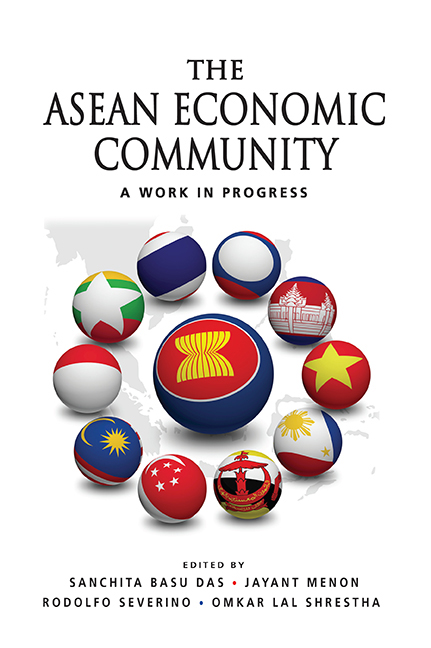Book contents
- Frontmatter
- Contents
- Foreword
- Foreword
- Preface
- acknowledgments
- Abbreviations
- The Contributors
- 1 Overview
- 2 Non-Tariff Barriers: A Challenge to Achieving the ASEAN Economic Community
- 3 ASEAN Trade in Services
- 4 The Asean Economic Community: The Investment Climate
- 5 Competition and Intellectual Property Laws in the ASEAN ‘Single Market’
- 6 Subregional Zones and ASEAN Economic Community
- 7 ASEAN FTAs: State of Play and Outlook for Asean's Regional and Global Integration
- 8 The Asean Dispute Settlement System
- 9 Enhancing the Institutional Framework for AEC Implementation: Designing Institutions that are Effective and Politically Feasible
- 10 ASEAN Economic Community Business Survey
- Index
Foreword
Published online by Cambridge University Press: 21 October 2015
- Frontmatter
- Contents
- Foreword
- Foreword
- Preface
- acknowledgments
- Abbreviations
- The Contributors
- 1 Overview
- 2 Non-Tariff Barriers: A Challenge to Achieving the ASEAN Economic Community
- 3 ASEAN Trade in Services
- 4 The Asean Economic Community: The Investment Climate
- 5 Competition and Intellectual Property Laws in the ASEAN ‘Single Market’
- 6 Subregional Zones and ASEAN Economic Community
- 7 ASEAN FTAs: State of Play and Outlook for Asean's Regional and Global Integration
- 8 The Asean Dispute Settlement System
- 9 Enhancing the Institutional Framework for AEC Implementation: Designing Institutions that are Effective and Politically Feasible
- 10 ASEAN Economic Community Business Survey
- Index
Summary
As 2015 approaches, that year, at least in the more knowledgeable parts of the countries of the Association of Southeast Asian Nations (ASEAN), is increasingly associated with the creation of the ASEAN Community. After all, ASEAN's leaders had declared in 2007 “ASEAN's strong commitments towards accelerating the establishment of an ASEAN Community by 2015”.
In 2009, the leaders issued the Roadmap for the ASEAN Community (2009–15) containing blueprints for the ASEAN Economic Community (AEC), which they had adopted in 2007, and the Political-Security and Socio-Cultural Communities.
The AEC Blueprint comes with a matrix called “Strategic Schedule”, most of which lays down very specific measures to be taken in 4 two-year tranches until 2015. With the support and collaboration of the Asian Development Bank, the Institute of Southeast Asian Studies (ISEAS) engaged experts, most of them leading authorities in their fields especially with respect to ASEAN, to examine the prospects of the AEC's achievement by 2015, identify the domestic political obstacles to that achievement, and suggest policy measures to address them.
The experts found that, if the commitments were to be taken literally and at face value, and if the obstacles were to be taken into account, it would be very difficult for the AEC measures to be carried out by 2015. While the ASEAN vision of creating an economic community marked by the free flow of goods, services, foreign direct investment and skilled labor and the “freer flow of capital”, is far-sighted, courageous and ambitious, too much political opposition and inadequate institutional infrastructure lie in the way of their effective implementation.
However, if the measures in the AEC Blueprint are to be regarded as ASEAN aspirations and commitments pointing in the general direction of creating the region as a single market and production base, and if the year 2015 is to be seen as a benchmark of progress in that direction, the AEC 2015 should be taken seriously not only by the ASEAN states but also by businesses and by not-for-profit organizations.
It is in this spirit that we at ISEAS consider the findings and conclusions of the prominent experts whom we have engaged.
- Type
- Chapter
- Information
- The ASEAN Economic CommunityA Work in Progress, pp. vii - viiiPublisher: ISEAS–Yusof Ishak InstitutePrint publication year: 2013



